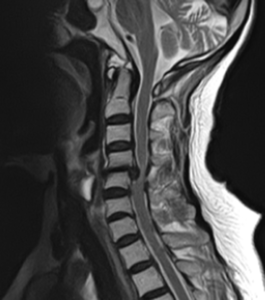Cervical Intervertebral Disc Herniation
2022年5月5日
最終更新日時 :
2023年9月26日
 webmaster
webmaster
We will provide information on the surgical methods, length of hospital stay, and insurance coverage for cervical disc herniation.
Cervical Disc Herniation
What is cervical disc herniation
Like lumbar vertebrae, cervical vertebrae also have intervertebral discs located between the vertebrae, serving as cushions and providing flexibility to the spine. With aging and other factors, cracks can develop in the surrounding fibrous ring, leading to cervical disc herniation, where the contents may protrude.

symptoms
The symptoms can vary depending on the direction of herniation, but it can lead to pain and numbness in the neck, shoulder, shoulder blades, and arm on one side, along with muscle weakness, by compressing the spinal cord itself or the nerve roots branching off from the spinal cord (nerve branches). On the other hand, when there is a large central herniation, it can compress the spinal cord itself, resulting in difficulty with fine hand movements, gait disturbances, and bladder and bowel dysfunction (frequent urination, urinary retention, urinary incontinence, etc.).
If strong pain and numbness are not improved with conservative therapy or if neurological impairments due to spinal cord or nerve root compression occur, early surgery may be required. Therefore, if you experience symptoms like those mentioned above, it is advisable to consult with a specialist in spinal cord and spinal disorders.
If strong pain and numbness are not improved with conservative therapy or if neurological impairments due to spinal cord or nerve root compression occur, early surgery may be required. Therefore, if you experience symptoms like those mentioned above, it is advisable to consult with a specialist in spinal cord and spinal disorders.
Surgical procedure
Surgery is categorized into anterior approaches (anterior decompression and fusion) and posterior approaches (spinal canal expansion) depending on the size and location of the herniated disc compressing the spinal cord.
-300x170.png)
